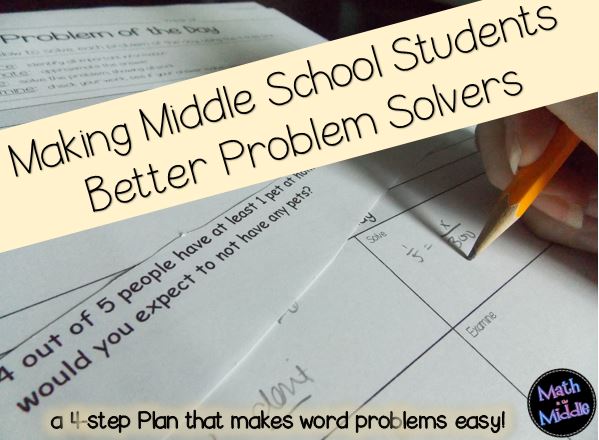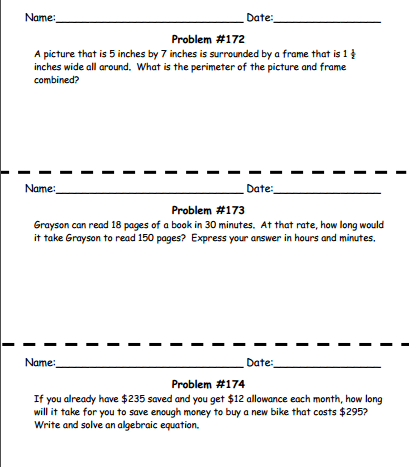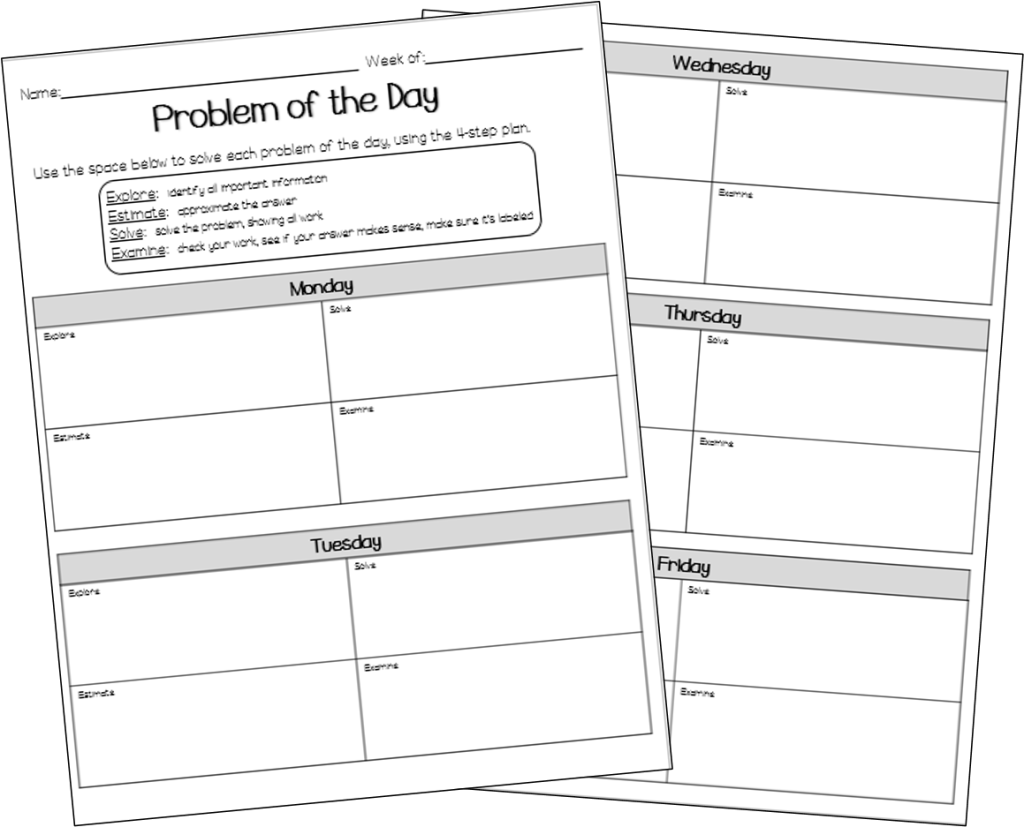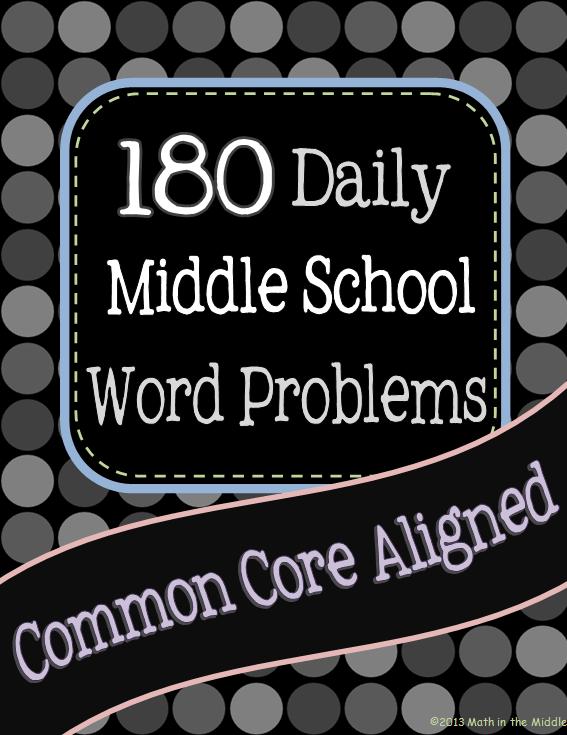“When am I ever going to use this?”
It’s the question every math teacher is asked, and while it may be annoying to hear, it is a good, valid question. It’s important for students to understand the reasons behind the math they are learning and that they know how to apply it to real-world situations. That’s why I consider problem solving to be the single most important part of my math classes. I place a lot of emphasis on word problems in my daily classes, in my homework assignments, and on my tests.
I typically assign a workbook page to my students each night for homework. My textbook series is pretty good about making sure each workbook page contains a couple of word problems, which is great, but there is one big flaw. If I am teaching a lesson on adding fractions, the workbook page contains a page full of fraction addition problems and two word problems on the bottom that require students to, (you guessed it), add fractions. To me, that isn’t problem solving. Students know without even reading the problem that they will need to add fractions because that is what the lesson was on. It’s good for them to see examples of how adding fractions is applied to real world situations, so I have students complete those problems, but it isn’t enough to make the students better problem solvers.
A few years ago I decided that I would have my students complete one word problem a day that wasn’t related to the day’s lesson. One problem that would make the kids have to stop and think about how to solve it, because to me, that is how students become better problem solvers.
I wrote 180 daily word problems for my advanced 6th grade math class and put the problems in both PowerPoint and printable forms. I either project the PowerPoint version of the word problem of the day as a do now or assign the printable version for homework, but every day my students are solving a multi-step word problem unrelated to the day’s lesson. Since it covers a topic they previously learned, it is also serves as a form of spiral review. Sometimes I collect the students’ work to see how each student solved the problem and sometimes we discuss them and compare/contrast strategies.
I have my students solve the problems using a four-step plan, which I say is EESE (pronounced easy):
- Explore – read the problem & identify any important information in it
- Estimate – approximate the answer using rounding and/or common sense
- Solve – solve the problem
- Examine – see if the answer makes sense, see if it’s close to their estimate, and make sure it’s labeled
To download a FREE double-sided weekly sheet students can use to complete a Problem of the Day using the 4 step plan, click the image below.
Since I have started my problem of the day program, I have seen a huge increase in both my students’ willingness to attempt word problems and their success in solving them.
If you are interested in my 180 Daily Middle School Word Problems, you can pick them up in my TpT store. They are typically $12, but are on sale today and tomorrow for 28% off with code BTS15. If you want to try them out before buying the set, you can download 10 days free!
What do you do to make your students better problem solvers? The first 3 people to respond with their problem solving strategies (and give their email address) will get a free copy of my first set of 45 Daily Middle School Word Problems!
Thanks for reading,
Christina







I agree about the lack of true problem solving needed to complete textbook work pages. We try to work on more complex problems in class and have a mathematical dialogue about them. I provide the students with some sentence frames to help facilitate the discussion. It’s powerful for the students to hear each other’s ideas and to realize for themselves that there can be different ways to approach the same problem. Lots of standards for mathematical practice are used by the students in these discussions too, so there’s another bonus! Thanks for the ideas!
Hi Amanda,
Thank you for your comment! I agree that mathematical dialogue is so important and helpful in fostering problem solving skills…the more students “talk math”, the better they get at it!
I’m sending you an email now!
Thanks,
Christina
I encourage my students to read the problems ouloud, draw pictures, use manipulatives. All of these should be in their toolbox of strategies. I also believe in math language and writing about how a problem is solved. I think this is beneficial for thinking processes and reflections. Thanks!
Hi Tina,
Thank you for your input. I think all of the strategies that you mentioned are important ones for students to use to help in their understanding of and solving of word problems.
Sending you a copy of the word problems now!
Thanks,
Christina
As already mentioned, getting the kids to talk about the math problem first, before even writing anything down on the paper, has proven to be beneficial. I also encourage students to circle key words and phrases that provide clues and to find similarities within the problems to other problems we have solved together in our math journals.
Hi Erin,
Key words and phrases can be very helpful to some students. I agree that looking for similarities to other problems can be a great strategy as well! Thanks for sharing…an email is on the way!
Thanks,
Christina
My students are such number grabbers. They find two numbers in a problem and apply whichever operation we have been using lately. It drives me crazy. I have tried to help them be better problem solvers by reducing the number of problems they do everyday and I require that they have to show the problem
In a second way….a picture, a model, a number line, something that shows they have a good understanding of the problem. We also share strategies they used as a whole group so students can learn new strategies from each other.
Hi Jessie,
That drives me crazy, too, which is why I started giving them unrelated word problems!! I like the idea of showing the problem another way – that sounds like a great way to make sure they really understand the problem! Thank you so much for sharing!!
I tried sending you an email with 45 Daily Word Problems but it said there was a mistake with your email address. Send me an email at mathinthemiddleblog@gmail.com and I will resend it to you!
Thanks,
Christina
I encourage my students to think about what the question is asking. Then circle, highlight, underline any information they think is relative and helpful to answering the question. Often I have students write about how they are going to solve the problem and why they have chosen that way to solve it. I am more interested in their thought process than the answer itself. I also have them explain and defend their reasoning to other students. This helps them to learn ways they had not thought about. The students seem to like showing off when they think of a way I had not. And what middle school student does not love being smarter than the teacher!
Hi Meagan,
Thank you for your response! The circling/highlighting/underlining is like my “explore” step of the 4 step plan. I absolutely agree that the process is more important than the answer!! I love the idea of having them explain and defend their reasoning as well.
Check your email for my 45 Daily Middle School Word Problems – they are on their way!
Thanks,
Christina
This is exactly what we are working on now in our homeschool classroom. I realized the same thing with our math program, and I want my daughter to be able to solve a word problem (and any other problem), without being told what she needs to do to solve it. Thank you for sharing your ideas!
You’re very welcome! 🙂
For the past three years I’ve incorporated a Problem of the Day (POD), as a daily math warm up. Like what you’ve mentioned, I find that my students will lack problem solving skills necessary for real-life applications. I use the PODs as an opportunity to not only incorporate more word problems but to also review concepts that are not in the current teaching unit. I also find that over time my students will feel more confident and willing to try more complex and multi-step problems, since they have encountered so many word problems through our PODs.
Thank you for sharing! I’m glad that you, too, have found that a word problem of the day has had a positive effect on your students’ problem solving!
– Christina
My district has is going to 75 minutes of Math this year. I think will be a huge advantage to what I can do in the classroom. I plan to start the class each day with a “warm up” or problem of the day. I really like your format for problem solving and strategies to solve word problems.
Karen
Pingback:Fun (Free) Ways to Celebrate Valentine’s Day in the Middle School Math Classroom | Math in the Middle